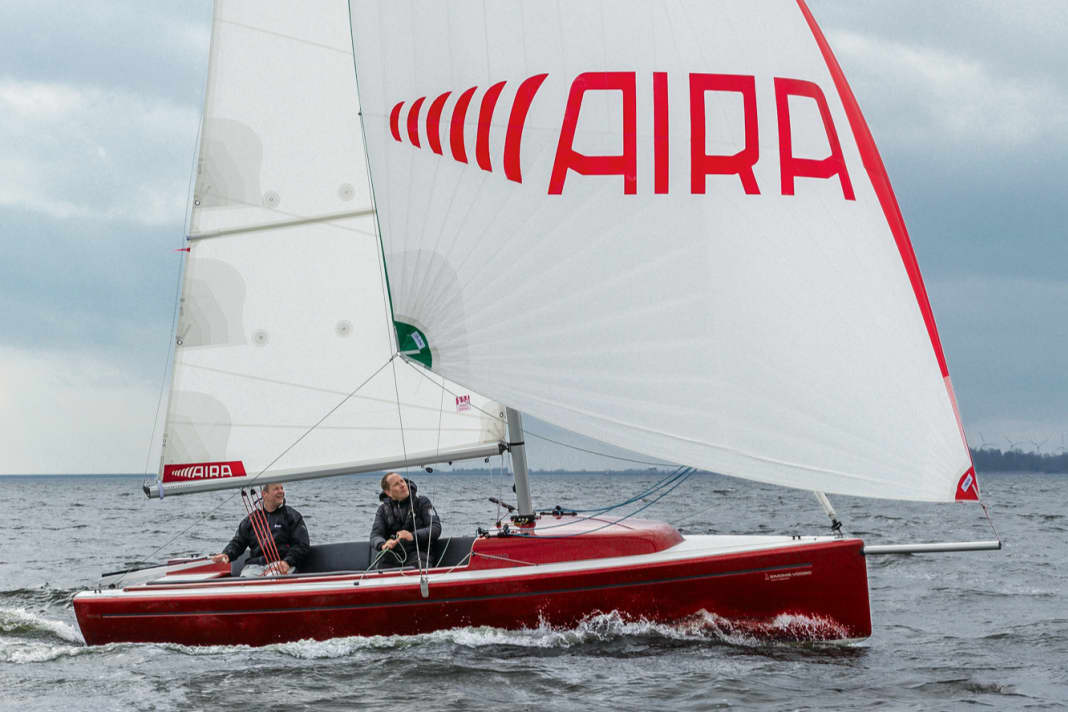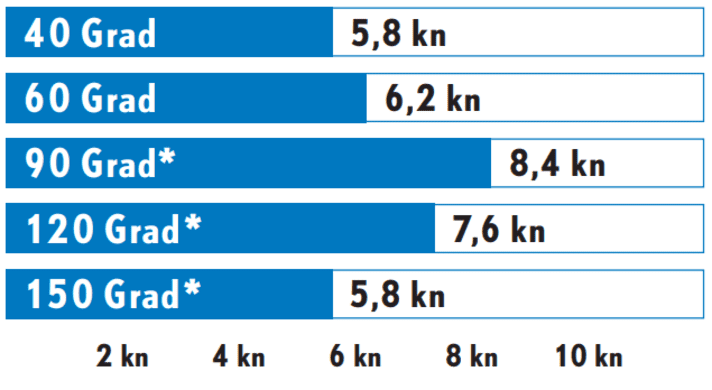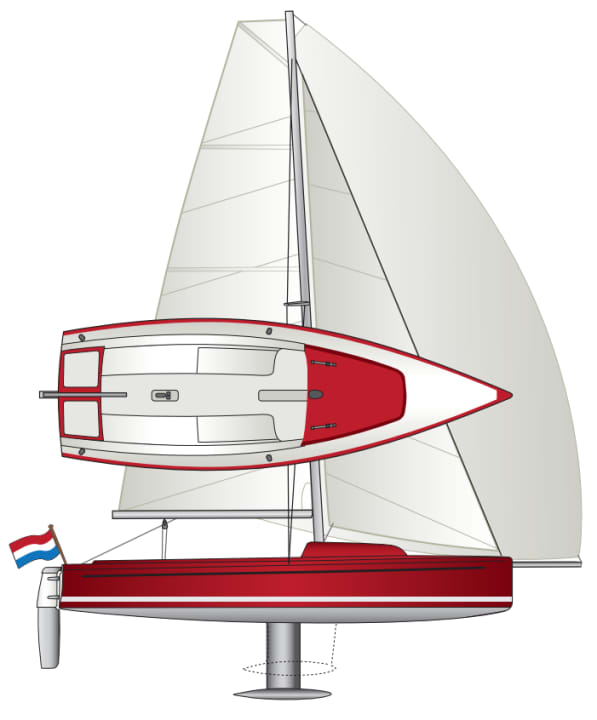





That couldn't be it, said Jos Snijders Blok to himself after he had sold all of his many sailing schools in Friesland. A new project was needed. And because Snijders Blok almost exclusively used Polyvalk boats in his businesses, the approach for a new task was quickly found. It was to be a modern version of the school and travelling boat, which was widely used in Holland in particular but was getting on in years - a kind of Polyvalk 2.0.
With these ideas in mind, Snijders Blok came together with designer Maarten Voogd (Simonis Voogd Yacht Design). The result of the collaboration was presented for the first time in January 2018 at boot in Düsseldorf, where it attracted a great deal of attention. The two pretty, colourful Aira 22 boats were a real crowd-puller in Hall 15. Not least because word quickly got around about what was on the price tag: Snijders Blok had launched its new boat, which is almost a small yacht, on the market for less than 15,000 euros. A really competitive price in comparison, which pleases potential buyers and annoys competitors. The price has risen since then, but at just over 20,000 euros it is still favourable.
However, the excitingly favourable price of the Aira 22 is not the only reason for the attraction. The general concept is also exciting and attractive, characterised in particular by a remarkably large variety and a high degree of versatility. The simple standard boat ex shipyard is the clubsailer version for a price of just €20,700 ready to sail including tax. In this version, the boat comes with a rubber rubbing strake and a soft, attached plastic nose, which can be easily replaced after a collision. The target groups are sailing schools, boat hire companies and clubs.
The Aira 22 can be functionally combined
The daysailer version is mainly aimed at water hikers and sailors who appreciate the unpretentious leisure pleasure on the water but shy away from the expense of a larger boat. In this version, the boat is equipped with an electrically extendable electric motor built into the aft peak. It also has upholstery on the thwarts and a cockpit table. The price: 24,700 euros, with electric motor included.
And as a match racer model, the Aira 22 can also be sporty, with a gennaker and extendable bowsprit. The performance boat is equipped with a slim and retractable T-keel from the shipyard. The sporty update comes at an additional cost of only around 2,000 euros compared to the standard boat.
Buyers can also combine all options as they wish, depending on their requirements and use. The lifting keel, for example, can also be fitted to the club or daysailer instead of the wider but less deep L-keel, for example if the boat is often transported by road or frequently slipped over the ramp. The rudder blade is attached to the stern for this purpose and can be easily removed with a flick of the wrist. The lightweight aluminium mast from Seldén can also be easily set and lowered by hand.
The test boat that YACHT was able to sail in 2018 documents the full variance of all feasibilities. This version is equipped with an electric motor, gennaker package and T-keel. However, the hull appendage has been shortened by 15 centimetres at the customer's special request. The draught of this boat is only 1.00 metres instead of 1.15 metres as originally planned by the shipyard. During testing off Enkhuizen on the IJsselmeer, this does not appear to be a disadvantage.
Safe, stable and fast
In around 12 knots of wind, the little Dutchwoman delivers an impeccable performance under sail. The boat gets through the short, steep waves very well, starts smoothly and sails very stiffly upwind despite the shortened T-keel. At a speed of 5.8 knots, the Aira 22 marches with two men at an angle of 40 degrees to the true wind. These figures are also impressive in comparison with recognised sports boats. It should also be noted that the simple Chinese-made Dacron sails supplied ex-shipyard can hardly really fulfil high demands.
Even with half the wind and with the gennaker hoisted, which is still clearly cut too short in the luff of the test boat, the boat makes fast progress. Nevertheless, at 700 kilograms, the comparatively light boat starts planing at 4 Beaufort and easily reaches 8.5 knots. And even on the deeper courses, the comparison with powerful sports boats is not wrong. The Aira 22 is easy to steer under pressure with the tiller, reacts quickly and sails in a controlled manner even when forced to heel.
According to the CE design category, the Aira 22 is suitable for sheltered waters (category D) and for up to six co-sailors in the cockpit. The large cockpit with 2.40 metre long benches is an advantage for use in sailing schools. Two or three people can actively sail the boat with a gennaker. Crews aiming for performance can also sit on the high edge and ride out. The shipyard can also equip the boat with foot straps if required.
The Aira 22 can only be sailed single-handed with a self-tacking jib
Soloists, on the other hand, will have a hard time. The jib sheet, which is led to both sides of the small deck superstructure, cannot be reached by the helmsman due to the rather long cockpit. The shipyard and designer have therefore now created the option of a self-tacking jib. Unrestricted single-handed capability is almost an imperative for a simple boat the size of the Aira 22.
According to the construction description, the beautifully deep cockpit should drain itself through the aft peak. However, on the test boat and with only two people on board, some water still runs back into the cockpit when sailing. This is not tragic, but can cause wet feet. The designers have also recognised this problem and intend to make improvements. Points are also deducted for the lack of foot rails on the foredeck.
Especially for use in sailing schools, this would be important for safety on board, especially as the rather coarse-textured anti-slip surface does not offer much grip, at least in wet conditions.
Precision landing
The Aira 22 is built as a sandwich construction with a foam core by a GRP specialist in Holland. The first construction numbers, such as the test boat, were still produced using wet hand lay-up. In series production, however, the boats are then built using the vacuum infusion process.
The side tanks and the forepeak are completely enclosed and watertight, making the Aira 22 unsinkable. Customers can also choose the look of their boat themselves from a wide range of colours. However, the colouring is not injected into the mould as coloured gelcoat at the start of the construction process, but painted on afterwards.
The Dutch company Aira Boats have done nothing wrong with their smart concept. And they seem to be meeting a revitalised demand for small, simple yet versatile sailing boats at their core. The very attractive price is also an attraction.
Measured values Aira 22
Sailing performance, without drift and current

Wind speed: 12 kn (4 Bft.) Wave height: approx. 0.50 metres,
* With gennaker
Potential STZ* = 5.2

Sporting ambitions. The Aira 22 is quite light for its size
*Dimensionless number. Calculation: 2√S/3√V. The higher the value, the more sail area (S) the ship has in relation to the displacement (V)
YACHT review Aira 22
Small boat from Holland for many different requirements and available in several versions. The Aira 22 impresses with good sailing characteristics and the low price is a real statement
Design and concept
- + Changeable concept
- + Robust construction
- - Water remains in the cockpit
Sailing performance and trim
- + Solid performance under sail
- - Not suitable for single-handed sailing without optional self-tacking jib
Equipment and technology
- + With fixed or lifting keel
- + Electric motor as an option
- - No foot railing on foredeck
Technical data Aira 22

- Designer:Simonis Voogd
- CE design category: D (6 pers.)
- Torso length: 6,50 m
- Width: 2,20 m
- Draught/alternative: 0,90/1,15 m
- Weight: 700 kg
- Ballast/proportion: 250 kg/36 %
- Sail area on the wind:22,0 m²
Hull and deck construction
Test boat GRP sandwich construction, series built using the vacuum infusion process
Price and shipyard
- Base price ex shipyard: 20,700 euros
- Price ready to sail*20,700 Euro
* how the prices shown are defined can be found here !
Shipyard and distribution
Aira Boats, NL-8601HG Sneek; www.airaboats.nl
This test first appeared in YACHT 11/2018

